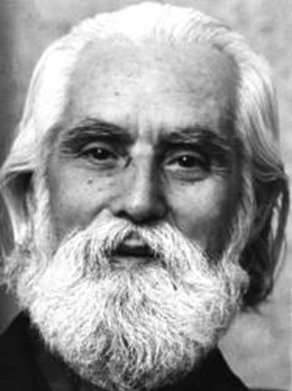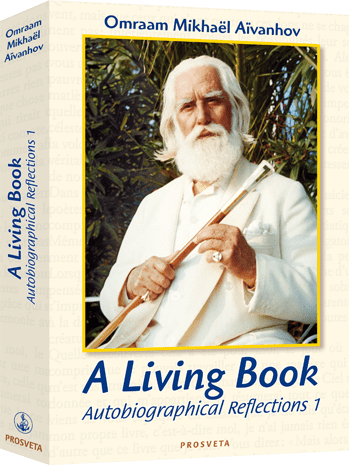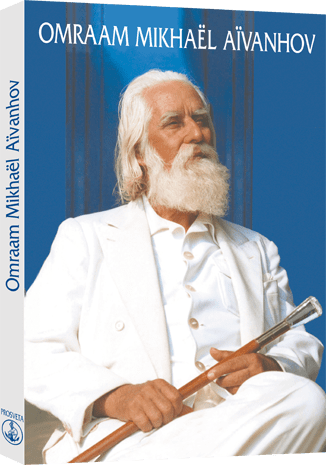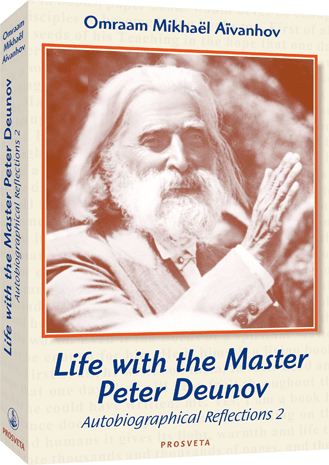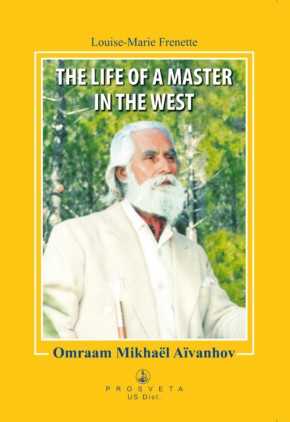Omraam Mikhaël Aïvanhov, a solar messenger
Omraam Mikhaël Aïvanhov (1900 — 1986) brought a Teaching in the tradition of the great sages of humanity. He explains the great laws of life and offers numerous methods for applying them, leading us to a better understanding of ourselves.
“Through my Teaching, I wish to give you essential notions about human beings: how they are structured, their relationship to nature, and the exchanges they must make with the universe if they are to drink at the springs of divine life… “
The Legacy
Omraam Mikhaël Aïvanhov left a legacy that has been widely known in the West since the middle of the 20th century and whose influence is still felt today. Many people have been inspired to improve their own lives, and some have gone on to write their own works of spiritual or esoteric inspiration, on wellbeing or personal development. So, through his radiance, his example and his Teaching, he has shown countless people the path of inner unfolding.
Many people around the world find in it a message of hope and an inspiration for a better conduct of their own lives. He was also a great reformer, who always worked to help and enlighten those who sought truth, bringing them new methods adapted to modern life.
Omraam Mikhaël Aïvanhov was convinced that peace on earth among all people is not only possible but indispensable and that most problems in modern day society will only be resolved when an ideal of brotherhood becomes humanity’s main objective. If all human beings are eventually able to consider themselves united, by fraternal links, if they rediscover and re-establish their spiritual dimension and origin, then universal brotherhood is possible, where everyone, regardless of origin, social rank or belief, can live in harmony within themselves, with others and with nature.
Biographical sketch
Omraam Mikhaël Aïvanhov was born on January 31st, 1900, in the town of Serbtzy in Macedonia and later lived in Varna in Bulgaria. His early years were marked by great difficulties: the loss of his father, poverty, constant social unrest and wars were all opportunities for him to develop his willpower, to deepen his spiritual knowledge and to reinforce both his love and his desire to be of use to his fellow human beings.
At the age of 17, he met Peter Deunov, the Bulgarian Master who was very well-known at the time in Bulgaria and whose reputation had spread well beyond his own country. For twenty years, the exchanges between Master and disciple were abundant and intense.
After his university studies, Omraam Mikhaël Aïvanhov became a teacher and then a school principal. At the same time, he faithfully followed the Teaching of Peter Deunov. An avid reader of books on spirituality, he experimented on himself the spiritual truths he heard from his Master.
His arrival in France
In 1937, sensing that the political troubles would bring with them a ban on all associations of a spiritual nature, Peter Deunov asked his disciple to leave for France in order to preserve and continue his work and to make this Teaching known, while developing it and adapting it to the new social conditions. In spite of difficulties and ordeals, Omraam Mikhaël Aïvanhov remained faithful to the mission he had received and tirelessly and selflessly gave his love, his knowledge and his attention to all those he met.
His voyage to India
In 1959, having worked for more than twenty years at the task given to him by Peter Deunov, Omraam Mikhaël Aïvanhov left for a voyage to India where he spent a year. On the 17th of June, 1959, he met the Mahavatar Neem Karoli Babaji(?–1973) whose role had long been that of a guide for prophets and Masters as described in Yogananda’s book “Autobiography of a Yogi’. In circumstances which he never fully disclosed, the Master received the name ‘Omraam’.
During this visit, he met many other gurus, including Ananda Moyi Ma (1896-1982), swami Nityananda (1896-1961), Anagarika Govinda (1898-1985) and swami Shivananda (1887-1963).
Until now, brother Mikhaël had refused to be addressed as Master by his disciples. He had always regarded himself as the disciple of his own Master, Peter Deunov. Following this stay in India, everything changed. His disciples, who had been following him for 22 years, insisted on paying him the respect he was due, and he finally agreed to be called ‘Master’.
The many countries visited
Germany, England, Bulgaria, Canada, Ceylon, Egypt, Spain, United States (California, Florida, Texas, New York, Washington D.C., Hawaii, and more) as well as the Caribbean and Hawaii, Ethiopia, Finland, Greece, Holland, Hong-Kong, India, Israel, Italy, Japan, Lebanon, Morocco, Norway, Sweden, Switzerland, Thailand, Yugoslavia.
Usually, he spent the end of the year and the beginning of the new year in Paris at the Center of Izgrev.
He then went to Switzerland to the Center of Vidélinata, above Vevey, for several weeks in February and March, until 1981.
For the Easter period, he went to the Domaine du Bonfin (in the south of France) where he also stayed during the international summer congresses (July to September).
In autumn, he often retreated in the Pyrenees (France), to a place called Trassoulas.
Key biographical dates
1900: January 31, birth
1907: spring, destruction of his native village and departure for Varna (Bulgaria)
1908: October, death of his father
1915: illumination - he hears the "music of the spheres"
1917: winter, first meeting with the Bulgarian master Peter Deunov
1923 - 1935: Sofia, university studies - obtaining a degree in education, psychology, and philosophy and attending courses in different faculties. Director of a school.
1937: July, arrival in France
1938: January, first public lecture, in a hall at place de la Sorbonne in Paris, on the subject of “the second birth”
June, first public lecture in Lyon, treating "spiritual electroplating" and prenatal education
1944: December 27, death of Peter Deunov at the age of 80
1945: First fraternal group in Switzerland, a country where he will stay frequently, especially in February-March
Christmas, publication of the first book, entitled "Love, Wisdom, Truth", with an introduction by Lanza del Vasto
1947: purchase of the “Izgrev” property in Paris where lectures and meetings take place
1948: January 16, the association Fraternité Blanche Universelle is officially created
January 21: Arrest on false charges
1950: March, liberation, which will be followed in 1960 by his rehabilitation
mid-March, 1950, resumption of contact with the brotherhood at Izgrev
1953: Opening of the first Congress at the Domaine du Bonfin, on the Côte d'Azur (France)
1959: February - departure for India
1960: February - return from India
1961 to 1985: frequent trips around the world
- stays in various countries during which he gave hundreds of lectures
- meetings with high-ranking religious and spiritual leaders
- thousands of private appointments
1972: publication of the first volume of the Complete Works
1986: last year spent at the Domaine du Bonfin (Var - France)
December 25, death at the Domaine du Bonfin
The name "Omraam"
In The Mystery of Light, a book about Omraam Mikhaël Aïvanhov, Georg Feuerstein explains that the name ‘Omraam’ is formed of two mantras, om and ram, which are well-known in India. He states that:
- om is the most sacred mantra of the Hindus, representing the Absolute or the Divine,
- and the syllable ram, which was written ‘raam’ in French to assist with the correct pronunciation, is the mantra denoting the fire element.
In the autobiographical work, A Living Book, Omraam Mikhaël Aïvanhov explains his initiatic name as follows: ‘Thus the name I was given in India, Omraam, corresponds to the two processes of solve and coagula of the alchemists: om dissolves all things, rendering them subtle, and raam materializes them, concretizes them. The name Omraam is therefore a whole process of concretization: the invisible, intangible idea that must incarnate on earth so that the whole world can see it, touch it.’
Transmission
He whom his disciples henceforth called Master, in the eastern sense of the term, which implies personal mastery and the talent of a pedagogue, liked to say that a true Master is a person who knows the truth, who understands perfectly well the laws and the principles of existence and respects them. A Master also has the will and the ability to master his inner world and to use this mastery for the sole purpose of "manifesting all the qualities and virtues of selfless love".
From 1938 until 1986, Omraam Mikhaël Aïvanhov gave nearly 5000 lectures, first in France (in Paris, Lyon, and a few years later at the Bonfin, near Fréjus on the Mediterranean coast) and in Switzerland, then in Canada, the United States, India, Sweden and Norway. The essential core of this abundant source of spiritual, esoteric and psychological knowledge is published by Prosveta, which has a presence on all five continents.
Fraternal groups, centers of light in the world
Omraam Mikhaël Aïvanhov established centers in several countries. These centers welcomed hundreds of people interested in his Teaching and in the fraternal life it offered.
In order to help those who came to listen to him and to live his Teaching, he assumed the role of pedagogue, conveying a clear understanding of the human structure with its different bodies and its two natures – the higher (or, in his terminology, the ‘individuality’) and the lower (or the ‘personality’) – knowledge of which, he said, is the key for resolving all of life’s problems. The purpose these centers, as he liked to remind us, was to establish centers of light in the world, creating a model of brotherhood, of the Golden Age which many teachings have foretold.
Until his death on December 25th, 1986, Omraam Mikhaël Aïvanhov gave thousands of lectures, received and talked with countless individuals and made many journeys throughout the world. He was a ‘bearer of light’, life-giving and loving, enthusiastic and accessible, who worked tirelessly for the wellbeing of everyone. He was an example, demonstrating perfect consistency of thought, word and action. Deeply anchored in unity, in the Self, and receptive to the subtle worlds, he was at the same time turned towards others, working at the core of everyday life for humanity, the whole earth and the universe. Omraam Mikhaël Aïvanhov can rightly be considered to be one among the realized Masters, the authentic Masters, who incarnate over the centuries in many countries.



His Teaching: A vision of universal life and Brotherhood
or Initiatic Science adapted to our time
The Teaching of Omraam Mikhaël Aïvanhov is based on a profound knowledge of the human being and his or her place in the universe, with an emphasis on the intuition of the heart and simplicity over superficial intellectual knowledge. Aware of the demands of working on oneself, he never stopped encouraging his disciples, inciting them to continue along the spiritual path leading to inner unity. What mattered to him was what one personally lived and experienced. With regard to this, he liked to say that it is not by analyzing an orange in all its aspects that we can know it, but by tasting it.
His Teaching is universal, and the many methods he gave are increasingly relevant to the changing mentalities and problems posed by the conditions of modern life. His constant preoccupation was always to be useful, to help people find in themselves the forces placed there by the Creator and so to be able to participate in the realization of a united global family, where each person is a citizen of the universe, a son or daughter of one cosmic principle. In this way, his Teaching invites all human beings throughout the whole world, regardless of skin color, nationality, religion or race, to achieve a life of dignity, for the good of each and every one of us.
A solar teaching
Omraam Mikhaël Aïvanhov described the emergence of a new consciousness using the term “solar”, in the image of the sun which distributes its light, warmth and life to all beings without distinction.
Helping human beings to rediscover their own spiritual dimension while finding their own stature in the world they inhabit was a central theme in the Teaching of Omraam Mikhaël Aïvanhov. All his works distributed by Prosveta (*) bear this message.
(*) Wellsprings of Life in the USA
